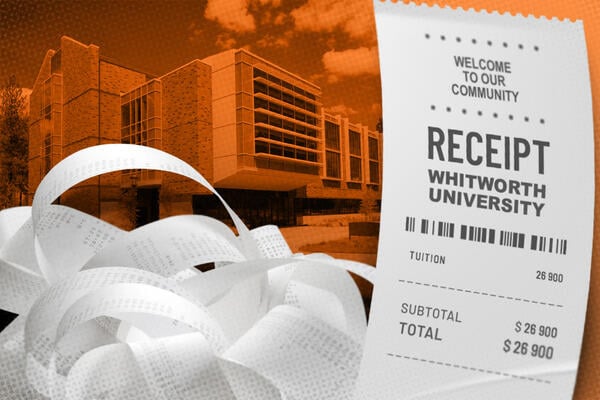
Whitworth Resets Tuition Amid Pleas for Cost Transparency
Whitworth University’s sticker price will be $26,900 starting next year.
Photo illustration by Justin Morrison/Inside Higher Ed | pixhook and seamartini/iStock/Getty Images | gregobagel/E+/Getty Images
It’s no secret that students are concerned about the cost of higher education; in a recent Inside Higher Ed/Generation Lab survey, the plurality of students (37 percent) said trust in higher education was declining because of a lack of affordability, followed closely by worries about the value of a degree.
College leaders often counter that higher education is significantly less expensive than the public believes it to be. Few students actually pay the sticker price—the full cost of tuition, which institutions must make public—thanks to federal, state and institutional grants and scholarships. This past academic year, the national discount rate for first-time, full-time undergraduates at private colleges rose to an all-time high of 56.3 percent.
But many families may be unaware of those steep discounts and thus steer clear of institutions with sticker prices out of their range.
Whitworth University, a private Christian institution in Spokane, Wash., is hoping to address that sticker shock with a new tuition model. Starting next fall, it will drop the annual cost of tuition from $54,000 to $26,900 and change merit-based discounts so they’re based purely on grade point average, with the scale publicly available. The recalibration is not intended to address shrinking enrollment, officials say; while Whitworth’s head count fell in the aftermath of the COVID-19 pandemic, that trend began reversing in 2023. Instead, officials say the tuition reset is a reaction to two years of research showing that students and parents crave clearer information about the cost of college earlier in the application process.
“We’re removing all of the behind-the-scenes algorithms and modeling that goes on for each individual student,” said Whitworth president Scott McQuilkin. “This is all about clarity, simplicity and responsiveness to families.”
The conventional wisdom among colleges has long been that it’s better to advertise high price tags that make their institutions seem like a luxury product and then offer scholarships so families feel like they’re getting a great deal. But as the public’s opinion of higher education has shifted to prioritize job placement and return on investment over classic liberal arts training, institutions are increasingly calling the opaque tuition-discount model into question.
“[It’s] mostly private institutions that are sold on this idea that parents love to brag about a $30,000 scholarship. Faculty, in my opinion, feel that their institution is of high value because the tuition is $60,000 a year,” said Josh Hibbard, Whitworth’s vice president of enrollment management. “I think it’s just a matter of time before the market really shifts. And maybe the market will pendulum back … [but] I just don’t see how much longer some of these private institutions are going to be playing that game.”
Hibbard said that Whitworth decided on its new $26,900 price tag by first creating the GPA-based scholarship scale and working backward, taking into account how much students currently pay and how much need-based aid they typically receive.
‘Rational and Transparent’
Huge drops in tuition prices are typically called tuition resets—although McQuilkin said Whitworth is avoiding the term, because the university is taking the additional step of providing maximum transparency about what merit scholarships students will receive; in the past, colleges that have reset their tuition have continued to offer confusing and opaque discounts.
These resets have had mixed success, according to James Dean Ward, vice president of research at Strada Education Foundation, who studies tuition resets. While they don’t correlate with overall increases in enrollment, Ward and his co-author, Daniel Corral, a University of Toronto professor of higher education, have found, they do correlate with increases in the number of Pell-eligible students, indicating that such resets might encourage lower-income students to consider colleges they otherwise wouldn’t have.
“We know that lower-income students are certainly more price-sensitive but potentially also more impacted by sticker shock,” Ward said. “So, by lowering that sticker price, it’s kind of opening up the door and hopefully improving their understanding of what college might cost … [and it] gives them the possibility of seeing themselves enrolling in some of these private institutions.”
So, why haven’t more colleges adopted the practice? According to Phillip Levine, a professor of economics at Wellesley College who studies college affordability and cost transparency, lower tuition still signals an inferior product to some.
“It doesn’t make sense for everybody to have a pricing strategy where they state a price that nobody pays and give everybody merit awards that can’t possibly, truly, be about merit if everybody is getting one,” he said. “In reality, what would be best for the country is if all institutions stopped doing that. And the reason why that doesn’t happen is because if all institutions stopped doing that, there’s an incentive for one to be like, ‘OK, let’s increase our tuition to signal higher quality and give more merit awards because that will signal our commitment to our students,’ and then they’ll be successful because that marketing strategy works … In the language of economics, that’s called a prisoner’s dilemma. It’s the worst outcome for everybody, but everybody’s incentives are aligned to follow that strategy.”
Levine also noted that if all colleges agreed to drop their prices to what students actually pay, that would be considered an antitrust violation—a problem some institutional leaders have been trying to solve for years now.
It’s unclear if changing attitudes toward higher education will, indeed, require colleges to reconsider their high sticker prices. Ward is currently working on research investigating how students respond to different pricing models. The results aren’t in yet, but his guess is that parents and students may stop seeing the appeal of a high price tag soon enough.
The effort has received overwhelmingly positive feedback at Whitworth in the weeks since it was announced, university leaders say. Hibbard has affixed to his computer two sticky notes with messages of gratitude from parents—one of a current Whitworth student and one of a prospective one—as a reminder, he said, that the institution made the right decision in slashing its price.
“It’s great to see someone finally say no to the silly game that is typical college tuition pricing,” the first note said. “I’m thrilled my daughter’s college is leading the way and making the whole system more rational and transparent.”
Source link



